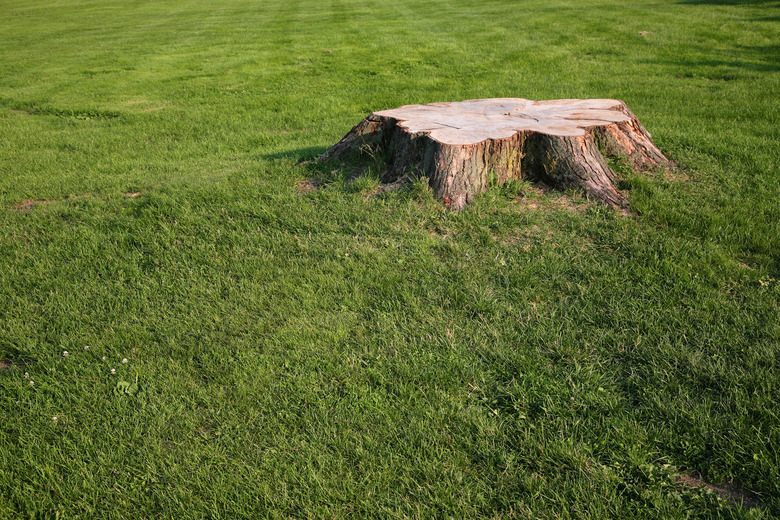Is Dirt Leftover From Stump Grinding In My Yard Good To Plant In?
When you must cut down a tree, the stump left behind can be an eyesore in your yard. Grinding the stump reduces it to sawdust, and you can often grind it down to a few inches below ground level. The sawdust changes the composition of the soil, so the area won't be ideal for immediate planting. Taking a few extra steps to clean up and refurbish the soil gets it ready for planting faster.
Nitrogen Neglect
Step 1
When the sawdust from the stump is left in the ground, the remaining soil ends up with a nitrogen deficiency — the sawdust is high in carbon rather than nitrogen. Most plants won't grow well in these conditions, and can end up looking stunted or suffering from yellowing leaves. Even grass doesn't like soil without nitrogen. Because nitrogen serves mainly as a nutrient to strengthen and green up the plant, grass often suffers more than other plants when the soil lacks nitrogen.
- When you must cut down a tree, the stump left behind can be an eyesore in your yard.
- The sawdust changes the composition of the soil, so the area won't be ideal for immediate planting.
Sawdust Removal
Step 1
If you want too plant right away, ask the company grinding the stump to dig out the sawdust from the hole as part of its stump-removal process. If it doesn't offer this service, or you were grinding the stump yourself, use a shovel to dig into the stump hole to remove as much sawdust as possible. It's mixed with dirt, so remove as much of both from the hole as you can. Refill the hole with sterile topsoil, mounding it a bit above ground level. It should level out as the dirt compacts and settles after a few waterings. Remember to wear protective gear such as safety glasses and gloves when using a stump grinder and thoroughly familiarize yourself with the equipment's operating instructions. Pregnant and nursing women should always wear gloves when working with soil, as soil bacteria can cause sickness or skin infections.
- If you want too plant right away, ask the company grinding the stump to dig out the sawdust from the hole as part of its stump-removal process.
- If it doesn't offer this service, or you were grinding the stump yourself, use a shovel to dig into the stump hole to remove as much sawdust as possible.
Be a Soil Doctor
Step 1
If you don't remove the sawdust or there is a lot left after you dig, take some time to rebuild the nutrients in the soil before you plant. Add a nitrogen-rich fertilizer, such as a 20-10-10, to the area where the stump used to be. Turn it into the top 6 to 8 inches of soil with a shovel or trowel. Plan on at least a pound per 1,000 square feet. Your stump area is significantly smaller than that, so calculate the difference. If the stump was 2 feet in diameter, multiply 2 times 2 for 4 square feet. Divide 4 by 1,000 for 0.004. When you multiply 16 ounces — or 1 pound — by 0.004, you get 0.06 ounces, so you'll need to spread about an ounce of nitrogen-rich fertilizer over the small stump area.
- If you don't remove the sawdust or there is a lot left after you dig, take some time to rebuild the nutrients in the soil before you plant.
- When you multiply 16 ounces — or 1 pound — by 0.004, you get 0.06 ounces, so you'll need to spread about an ounce of nitrogen-rich fertilizer over the small stump area.
Same Spot, New Tree
Step 1
When you want to replace the felled tree, pick a spot a few feet away from the old stump instead of putting the new tree in exactly the same place, if possible. Spacing the new tree at least 3 feet from the old stump lets it take advantage of better soil quality — garden soil free of sawdust, for example — without its roots bumping into too many roots of the old tree. The old tree's roots decay slowly, but they add nutrients to the soil as they degrade, so planting near — but not in the middle of — the roots can help your new tree grow.
References
- University of Illinois Extension: Don't Plant New Tree Atop Recently Ground Stump
- Andrew's Tree Pros: Removing Stumps and Planting Grass
- Pennsylvania Patriot News: Replanting After a Stump Grinding
- University of Illinois Extension: Materials for Composting
- National Park Service: Clippings
- University of California Statewide Integrated Pest Management Program: Starter Fertilizer
